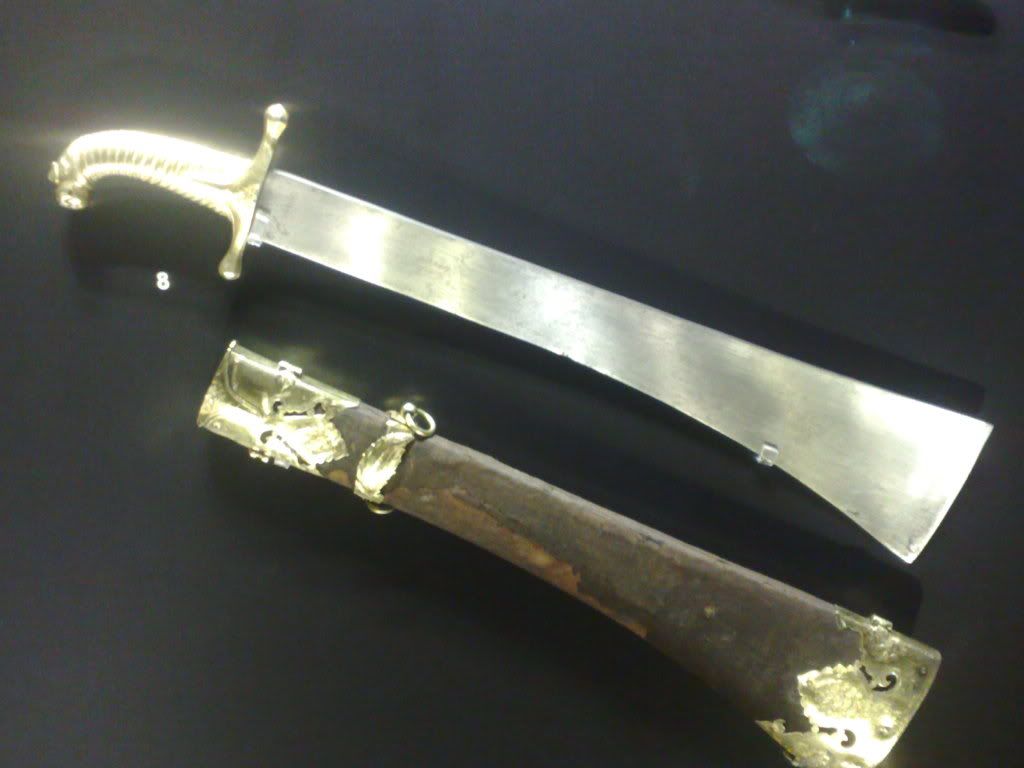
 |
|
|
|
|
#1 |
|
Member
Join Date: Oct 2005
Posts: 420
|
This is the description from the Oriental Arms site:
“Naga people of Assam (North-East India) and the Kachin people of Myanmar (Burma) The Naga people of Assam (North-East India) and The Kachin people of Myanmar (Burma) uses this very efficient sword / cleaver. It has a very heavy blade, widening to maximum width at its very top. This one is a classical example. Heavy single edge beveled blade 19 inches long. Wood grip with flared pommel covered with red lacquer and set with a ivory pommel cover. Silver grip collar. The scabbard is open on one side, bound also with braided rattan band and braided silver wires to hold the blade in place. Total length 31 inches (in scabbard). Very good condition. Minor wood nicks on the blade.” As I understand it, Dao is more or less just the Chinese word for sword. Is there a more specific name for this sort of sword? |
|
|

|
|
|
#2 |
|
Member
Join Date: Oct 2007
Posts: 2,818
|
Dah is the more specific word for sword within the regions from which they come.
|
|
|

|
|
|
#3 |
|
Member
Join Date: Aug 2007
Location: Germany, Dortmund
Posts: 8,779
|
Hello Kurt,
beautiful sword! Here a link which may be interesting for you: http://www.arscives.com/historysteel....swordlist.htm I know this swords only named as Dha or Dao. Regards, Detlef |
|
|

|
|
|
#4 |
|
Member
Join Date: Oct 2005
Posts: 420
|
Detlef, thanks for the link.
What I am seeing is that Dao is generic chinese for sword, while Dah (or Dha) is more specific for Burmese swords. However Dah usually refers to one sort of Burmese sword: http://www.oriental-arms.co.il/item.php?id=5864 Marcus P.S. Who's Kurt? |
|
|

|
|
|
#5 |
|
Member
Join Date: Oct 2007
Posts: 2,818
|
Hi Marcus,
Dah is the correct term used by many living with and studying the Kachin tribes from the 19th century onwards, it is well referenced. Either names used with the pictures in context would suffice though. I prefer the name Dao when used but it is regionally incorrect. Regards Gavin |
|
|

|
|
|
#6 | |
|
Member
Join Date: Aug 2007
Location: Germany, Dortmund
Posts: 8,779
|
Quote:

|
|
|
|

|
|
|
#7 |
|
Vikingsword Staff
Join Date: Dec 2004
Location: The Aussie Bush
Posts: 4,200
|
Technically, this style of Naga sword has been called a sword-dao (see Rawson, The Indian Sword, and this link http://www.vikingsword.com/ethsword/nagadao/index.html).
For a more detailed explanation of nomenclature, see this online article: http://www.arscives.com/historysteel...ea.article.htm Ian. |
|
|

|
|
|
#8 |
|
Member
Join Date: Sep 2013
Posts: 79
|
I have a theory that this item in Topkapı Palace Museum Armory(which is identified as a executioner's sword for some reason) is actually a broken/short Naga sword that is fitted to a 19th-20th century(possibly european style) hilt and a scabbard.
 I'd like to remind you that there are many blades from the İndian subcontinent and Soth East Asia in Topkapı Armoury; many of them rehilted. |
|
|

|
|
|
#9 | |
|
Member
Join Date: Oct 2007
Posts: 2,818
|
Quote:
|
|
|
|

|
|
|
#10 |
|
Member
Join Date: Nov 2008
Posts: 88
|
The Jinghpaw (the main Kachin dialect) word for sword is nhtu. Dah is Myen-ga (Burmese language); Dao is Muwa-ga (Chinese). Hkahku (upriver) and Duleng are Jinghpaw sub-groups. Nung, or more properly Anung are a Rawang sub-group.
|
|
|

|
|
|
#11 | |
|
Member
Join Date: Jul 2005
Location: Toronto, Canada
Posts: 1,242
|
Hello Sancar,
I think the piece you show is more likely part of a hunting trousse of European origin. These kits for preparing the animal carcass onsite often included large cleavers with weird blades (see attached example). As Gavin noted, the Naga dao in question has the edge on the straight side, with a concave spine. While there are Naga blades with concave edges they are quite different from the Topkapi piece. Emanuel Quote:
|
|
|
|

|
|
|
#12 |
|
Member
Join Date: Oct 2005
Posts: 420
|
I appreciate the information and links.
Marcus |
|
|

|
|
|
#13 |
|
Member
Join Date: Oct 2007
Posts: 2,818
|
Ian, technically, what you are looking at is a Kachin Dah from the Kachin Tribes and regions.
http://en.wikipedia.org/wiki/Kachin_State The sword type is from the Hkahku, Nung, Duleng, Jinghpaw and other Kachin tribes and is very well evidenced. There is a historical photo I know of showing a similar sword initially pictured here with a young Nung man, albeit the scabbard carries more yellow pigment. Rawson's reference, plate 37 in my edition, is noted as being from the Khamti Shan, a region that borders Kachin states. Beyond Kachin boundaries and border states such as the Khamti Shan that Rawson notes, these are very rarely seen and likely the result of raid rather than trade or manufacture. I do not recall the sword type pictured in Egerton. Stone, whilst good to refer to doesn't offer any support for what he based the description of figure 4 on but does note specifically the Naga dao sword types as "With no Distinct pommel" so I can see how he grouped the standard demure pommeled sword of his for his book. Being a traditional Kachin sword the correct term is Dah Last edited by SwordsAntiqueWeapons; 1st September 2014 at 04:37 PM. |
|
|

|
 |
|
|